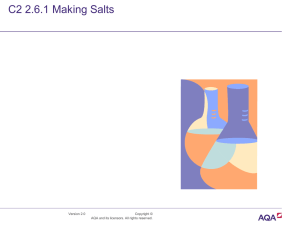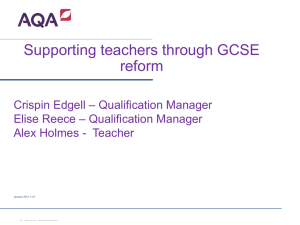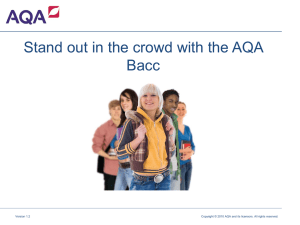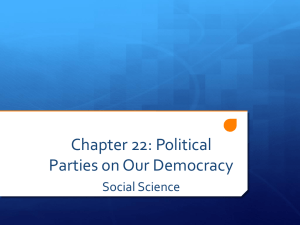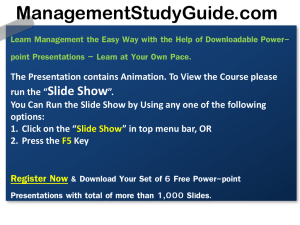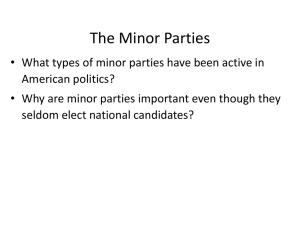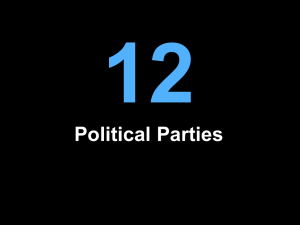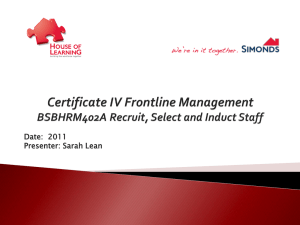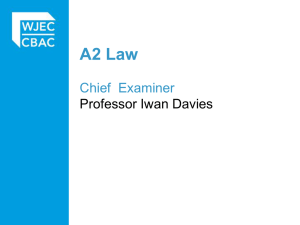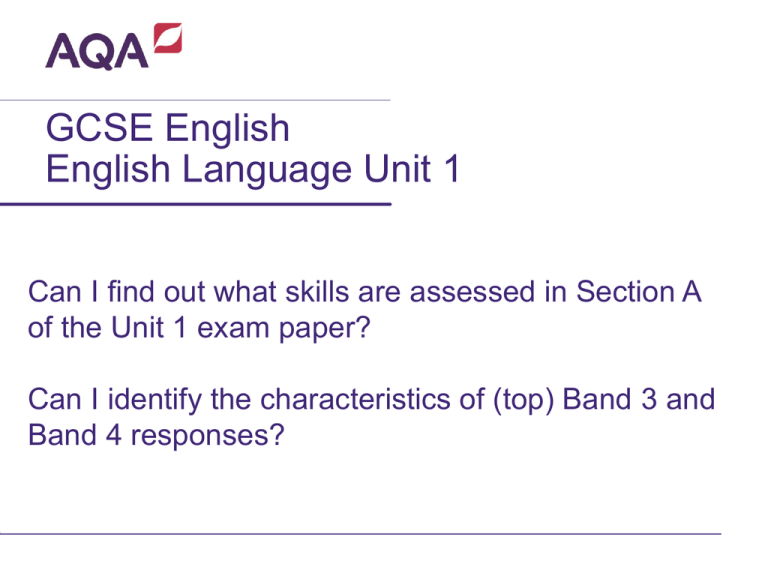
GCSE English
English Language Unit 1
Can I find out what skills are assessed in Section A
of the Unit 1 exam paper?
Can I identify the characteristics of (top) Band 3 and
Band 4 responses?
Percentage of candidates achieving Band 3 and above
70
60
50
Q4 - 21%
Q3 - 58.1%
Q2 - 57.1%
Q1 - 64.2%
40
30
20
10
0
Q1
Slide 5
Q2
Q3
Q4
Unit 1H: Section A Reading
•
Question 4 is a tricky one and needs extra practice: it asks you to
COMPARE the use of language in two texts
•
Each Reading question is testing a completely different skill, and you have
to demonstrate the right skill in the right place.
•
Many candidates, including those who are very able, fail to demonstrate
the right skill in the right place.
•
We need to understand the key skills needed for each of the Reading
questions, with some sample responses to exemplify
Slide 7
Copyright © AQA and its licensors. All rights reserved.
Q1: Read Source 1, Will turning vegetarian save the planet? by Alex
Renton.
What do you understand about the issues of vegetarianism and eating
meat from the article?
Q1 Read Source 1, Children… by Oliver Moody.
What do you understand from the article about the issues of children
and the outdoors?
(8 marks)
Copyright © AQA and its licensors. All rights reserved.
•
Slide 8
Q1 skills
•
Candidates are being asked to retrieve the important information and ideas
in an article. To retrieve something means to find it in the text.
•
Candidates are being asked to support the important information and ideas
that they retrieve. To support something means to back up what they say
with evidence from the text.
•
Candidates are being asked to interpret the important information and
ideas that they retrieve. To interpret something means to ‘read in between
the lines’. It’s what they can work out from the text without actually being
told. To show that they understand the article, candidates are expected to
do more than just retrieve.
•
Candidates are expected to comment on both issues: vegetarianism and
eating meat.
Slide 9
Copyright © AQA and its licensors. All rights reserved.
Question One Mark Scheme
Copyright © AQA and its licensors. All rights reserved.
In the article, Alex Renton is stating points for and against the idea of everybody
turning . From this article I have got to understand that the livestock reared for
humans to eat such as ‘sheep and pigs’ produce even more greenhouse gases than
the sources of transport like ‘cars and aeroplanes’ that we usually associate with
greenhouse gases, so maybe eating meat is harming the planet more than was
first .
On the other hand it has been argued that a ‘rich world vegetarian’ consumes nearly
the same amount of the ‘planet’s resources’ as a normal meat eater. This makes
me wonder whether everyone turning vegetarian would really improve the planet in
any way as either way the earth’s resources are being .
Vegetarians usually eat meat substitutes or food made of soya. From this article I
have understood that the ‘Worldwide Fund for Nature’ has reported that growing
soya and meat substitutes actually uses more land and resources than a meat
equivalent, meaning that a lot more deforestation and loss of habitat is happening
due to a large population of people being .
The article has also revealed to me that meat eaters have to eat sustainably if they
want the future generations ‘to enjoy a perfect steak’ and that eating meat should
become ‘more of a luxury’, something that we rarely eat. I have also gained that
the average Briton eats ’50 grammes of animal protein’ each day which is an amount
as it is much more than what an average person needs to stay healthy. This article
has revealed that people are not thinking about the costs of meat eating and its
impact on the environment around us.
Copyright © AQA and its licensors. All rights reserved.
From this article we understand that eating meat is causing ‘more greenhouse
gas emissions’ than modes of transports put . Paragraph one is suggesting
that ‘people’s diets’ ought to change so that the ‘planet can support more
people’. The initial argument is that ‘meat is a wasteful use of water’.
However, later on in the article it is suggested that becoming a vegetarian may
not help ‘save the planet’. We understand that ‘vegetarian meat substitutes’
actually use more land and resources than their ’.
The article also suggests other factors affecting the impact of food production
in our planet. The idea that ‘poorer countries develop’ may be an indirect
reason for the increase in meat eaten. Similarly, ‘deforestation in the
developing world’ perhaps to use land to grow cheap soya for human and
animal food’. The article seems to itself as vegetarianism may ‘reduce
greenhouse gases’ but growing the crops ‘uses more land resources’.
The article concludes by coming to a where eating ‘local meat, sustainably
produced’ and also reducing the intake would help rather than completely
avoiding meat.
Copyright © AQA and its licensors. All rights reserved.
•
Candidate A commentary:
•
This response demonstrates a clear understanding of both sides of the
argument, with touches of perception in places. Engagement becomes
increasingly detailed and appropriate quotations are used to support.
•
It is awarded a mark of 7 in Band 4.
Slide 11
Copyright © AQA and its licensors. All rights reserved.
•
Candidate B commentary:
•
This response demonstrates a clear understanding, although mostly
through retrieval. It covers a range of points and uses quotations to support
that are mostly appropriate.
•
It is awarded a mark of 5 in Band 3.
Slide 13
Copyright © AQA and its licensors. All rights reserved.
Raising performance
•
To achieve Band 4, candidates need to discuss all aspects of the issue or
issues in detail.
•
Candidates should not include any additional information in their response.
Everything they say should come from the text.
•
If there is a picture in the article, candidates should not comment on it. It is
just there to help their understanding of the text.
•
Candidates should not comment on the use of language for this question.
Comments on the use of language do not gain them any marks in Q1.
Slide 14
Copyright © AQA and its licensors. All rights reserved.
Raising performance
• It is a good idea for candidates to work their way through the text in
the order in which things happen so that they can retrieve the
important information and ideas in a logical way.
• It is a good idea for candidates to include phrases such as ‘this
suggests that…’ or ‘this indicates…’ so that the examiner can see
that they are beginning to interpret.
• It is a good idea for candidates to start their response with an
overview sentence to show they have a grasp of the whole
argument before then going into detail.
Slide 15
Copyright © AQA and its licensors. All rights reserved.
Over to you
Answer a Q1 past paper question,
aiming for 7/8 marks.
Copyright © AQA and its licensors. All rights reserved.
• Can I understand the assessment
requirements of Question 2?
Copyright © AQA and its licensors. All rights reserved.
Q2: Now read Source 2, ‘A ticking time bomb’: Teenage girls’ junk food diet
leaves them starved of vitamins by Fiona Macrae.
Explain how the headline and picture are effective and how they link to the
text.
Copyright © AQA and its licensors. All rights reserved.
•
Slide 16
Q2 skills
•
Candidates are being asked to comment on the effect of the words used in
the headline.
•
Candidates are being asked to comment on the effect of the details used in
the picture.
•
Candidates are being asked to select actual words and phrases from the
text and explain how they link with the headline.
•
Candidates are being asked to select actual words and phrases from the
text and explain how they link with the picture.
Slide 17
Copyright © AQA and its licensors. All rights reserved.
What qualities characterise a Band 3/4 response?
Slide 18
Copyright © AQA and its licensors. All rights reserved.
Copyright © AQA and its licensors. All rights reserved.
•
Candidate C commentary:
•
This response demonstrates a detailed explanation and interpretation and
makes perceptive comments. However, there are places where the
interpretation is less secure and contradictory.
•
It is awarded a mark of 7 in Band 4.
Slide 19
Copyright © AQA and its licensors. All rights reserved.
•
Candidate D commentary:
•
This response demonstrates a clear effect and some clear links.
•
It is awarded a mark of 5 in Band 3.
Slide 21
Copyright © AQA and its licensors. All rights reserved.
Raising performance
•
To achieve Band 4, candidates need to discuss both the effects of the
words used in the headline and the effects of the details used in the
picture.
•
Candidates should select actual words and phrases from the text in order
to link with the headline and picture.
•
Candidates are not being asked to link the headline and picture together.
•
Candidates should avoid generalisations when commenting on effects, ie
‘this is effective because it creates a picture in your mind’ or ‘this is
effective because it makes you want to read on’. The effects of the words
or details need to be connected to the article they are reading.
Slide 22
Copyright © AQA and its licensors. All rights reserved.
Raising performance
•
Scale, colour and camera angles, along with facial expressions or what is
happening in the background of a picture, are useful details for candidates
to consider.
Slide 23
Copyright © AQA and its licensors. All rights reserved.
Can I summarise the assessment
requirements for question 3?
The vast expanse of crystal stars
glimmering in a flat black sky
Diesel belched
from lorries and
buses.
I loved the desert, its
immensity, its silence
Butchered meat hung in the heat,
blackened by flies
Copyright © AQA and its licensors. All rights reserved.
Q3: Now read Source 3, In Search of
Olives, which is an extract from a non-fiction
book.
Explain some of the thoughts and feelings
the writer has during her journey.
Copyright © AQA and its licensors. All rights reserved.
•
Slide 24
Q3 skills
•
Candidates are being asked to select parts of a text which convey some of
the thoughts and feelings of a character (or characters). These parts may
include what is happening, what the character is saying or what the
character is doing.
•
Candidates are being asked to identify the thoughts and feelings of a
character (or characters) from the parts of the text that they select.
•
Candidates are being asked to interpret the thoughts and feelings of a
character (or characters) from the parts of the text that they select. This is
the most important part of the candidate’s explanation. To interpret
something means to ‘read in between the lines’. It’s what they can work out
from the text without actually being told.
Slide 25
Copyright © AQA and its licensors. All rights reserved.
Highlight and plan
• Highlight words and phrases that you can use to make perceptive
INFERENCES about her thoughts and feelings
• Plan out the FOUR ideas and feelings that you would like to pull out
of the text, support and explain.
• Remember, you don’t need language analysis until Q4 – but you do
need to ‘read between the lines’ in some detail
Copyright © AQA and its licensors. All rights reserved.
Band 3 response
Copyright © AQA and its licensors. All rights reserved.
Band 4 response
Copyright © AQA and its licensors. All rights reserved.
What qualities characterise a Band 4 response?
Slide 26
•
Candidate E commentary:
•
This response demonstrates a detailed and perceptive explanation and
interpretation of thoughts and feelings. Appropriate quotations are
employed throughout.
•
It is awarded a mark of 8 in Band 4.
Slide 27
Copyright © AQA and its licensors. All rights reserved.
Assessing weaker responses
Slide 28
•
Candidate F commentary:
•
This response mostly demonstrates a clear understanding, and begins to
interpret in places, although the range of thoughts and feelings is rather
narrow.
•
It is awarded a mark of 5 in Band 3.
Slide 29
Copyright © AQA and its licensors. All rights reserved.
Raising performance
•
To achieve Band 4, candidates need to explain a range of thoughts and
feelings in detail relating to the whole text.
•
Candidates should not comment on the use of language or the effect on
the reader for this question. Comments on the use of language or the effect
on the reader do not gain them any marks in Q3.
•
It is a good idea for candidates to work their way through the text in the
order in which things happen so that they can retrieve the important
information and ideas in a logical way.
•
It is a good idea for candidates to include phrases such as ‘this suggests
that…’ or ‘this indicates…’ so that the examiner can see that they are
beginning to interpret.
Slide 30
Copyright © AQA and its licensors. All rights reserved.
Raising performance
•
It is a good idea for candidates to start their response with an overview
sentence to show they have a grasp of the whole text before then going
into detail.
Slide 31
Copyright © AQA and its licensors. All rights reserved.
Language Features
• How many language techniques can you
remember?
• List them in your book – what could you
look for in an unseen text?
Copyright © AQA and its licensors. All rights reserved.
Q4: Now you need to refer to Source 3, In Search of Olives and either Source
1 or Source 2. You are going to compare the use of language in two texts, one
of which you have chosen.
Compare the ways in which language is used for effect in the two texts. Give
some examples and analyse the effects.
Copyright © AQA and its licensors. All rights reserved.
•
Slide 32
Q4 skills
•
Candidates are being asked to compare the use of language in two texts.
To compare means to look at the similarities and differences.
•
Candidates are being asked to select actual words, phrases or language
features that have been deliberately chosen in order to create an effect on
the reader.
•
Candidates are being asked to comment on the effect on the reader of
using these words, phrases or language features. This is the most
important part of the candidate’s response.
Slide 33
Copyright © AQA and its licensors. All rights reserved.
Band 3 response
Copyright © AQA and its licensors. All rights reserved.
Band 4 response
Copyright © AQA and its licensors. All rights reserved.
•
Candidate G commentary:
•
This response demonstrates a full and detailed understanding of the texts
in relation to language, especially Source 3. There is evidence of close
analysis with perceptive comments and appropriately chosen quotations.
•
It is awarded a mark of 15 in Band 4.
Slide 35
Copyright © AQA and its licensors. All rights reserved.
Assessing weaker responses
Slide 36
•
Candidate H commentary:
•
This response demonstrates a clear understanding in relation to language.
There are both clear effects and clear comparisons.
•
It is awarded a mark of 10 in Band 3.
Slide 37
Copyright © AQA and its licensors. All rights reserved.
Raising performance
•
Candidates are not comparing the content of the texts or the structure of
the texts. Everything they say needs to be focussed on the use of
language.
•
The purpose and audience of a source are only important in so much as
they determine the writer’s choice of language. They should not be the
focus of the candidate’s response.
•
The mark band is determined by the quality of the explanation of why a
writer has chosen to use a particular word, phrase or language feature and
the effect of this choice on the reader.
•
It is therefore essential for candidates to select examples of language that
enable them to analyse the effects on the reader effectively.
Slide 38
Copyright © AQA and its licensors. All rights reserved.
Raising performance
•
Candidates should avoid generalisations when commenting on effects, ie
‘this is effective because it creates a picture in your mind’ or ‘this is
effective because it makes you want to read on’. The effects of the words
or details need to be analysed in context.
•
It is a good idea for candidates to include words or phrases that show
similarities and differences to make it clear that they are comparing, for
example, ‘both’, ‘is similar to’, ‘on the other hand’, ‘however’ and ‘whereas’.
Slide 39
Copyright © AQA and its licensors. All rights reserved.
Slide 40
Unit 1: Tier F: Question 1a
It sounds obvious but ……..
KEEP CALM AND READ THE QUESTION
•
•
In January 2013 82% of candidates scored full marks on Question 1a.
In June 2013 only 45% of candidates scored full marks on Question 1a.
What caused this significant drop on what is designed to be the most
straightforward task in a test of Reading?
Slide 41
Copyright © AQA and its licensors. All rights reserved.
Unit 1 Tier F: Question 1b and 2
•
The average mark on Question 2 is a healthy 5 out of 8.
•
This suggests that many candidates are able to show two out of three of
the skills required in Band 2 of the mark scheme.
•
Interestingly, the average mark on Question 1b, where the skills are exactly
the same, remains at 2 out of 4.
•
This suggests candidates are again missing out one crucial element to help
them hit all the skills in Band 2.
Look at the mark scheme grids which follow.
What might be needed to help them show all of the required skills?
Slide 42
Copyright © AQA and its licensors. All rights reserved.
Unit 1 Tier F: Using Supporting Quotation
Many centres have obviously worked hard to give candidates a clear method
to answer Question 1b and 2, based on the ladder of the mark scheme and
based on advice in previous Principal Examiner’s reports:
Statement + Quotation + Inference
mirroring the P.E.E method many colleagues have taught for a very long time!
By double checking the mark scheme ‘ladder’ of skills, we can see how this
method fits perfectly.
So, where do the problems arise?
Slide 43
Copyright © AQA and its licensors. All rights reserved.
Unit 1F: Inference
•
When is an inference not an inference?
•
Consider this example:
Candidate A:
From the text we learn that Amy liked performing, ‘Just about the only thing
she seemed to enjoy about school was performance.’ This suggests to us that
in school Amy really enjoyed performance and it was the only thing she really
liked.
What problems can you identify with this response?
Slide 44
Copyright © AQA and its licensors. All rights reserved.
Unit 1F: Inference
Candidate A:
From the text we learn that Amy liked performing, ‘Just about the only thing
she seemed to enjoy about school was performance.’ This suggests to us that
in school Amy really enjoyed performance and it was the only thing she really
liked.
•
Although this candidate is using the SQI method, they are paraphrasing the
quotation in both the statement and the inference. This perhaps only shows
a simple engagement with the text.
Slide 45
Copyright © AQA and its licensors. All rights reserved.
Unit 1F: Inference
Candidate B:
One thing we learn about Amy’s schooldays is that she loved singing and
being in the school shows, ‘Just about the only thing she seemed to enjoy
about school was performance’. This tells us that Amy was only really
interested in the subject she enjoyed and was good at - performing arts.
What strengths can you identify with this response?
Slide 46
Copyright © AQA and its licensors. All rights reserved.
Unit 1F: Inference
Candidate B:
One thing we learn about Amy’s schooldays is that she loved singing and
being in the school shows, ‘Just about the only thing she seemed to enjoy
about school was performance’. This tells us that Amy was only really
interested in the subject she enjoyed and was good at - performing arts.
•
In this example, we can see a clear statement, supported by a quotation.
•
The inference is not a paraphrase of either the statement or quotation. It
shows something has been deduced by the candidate, thereby
demonstrating their understanding of the text.
Slide 47
Copyright © AQA and its licensors. All rights reserved.
Unit 1F: Question 4
The average mark on Question 4 is still only 4.64.
This means that the vast majority of candidates are only meeting the criteria
for all of Band 1 (4 marks) or are just narrowly edging to 5 marks in Band 2.
Identify one key problem your candidates encounter with Q4
Slide 48
Copyright © AQA and its licensors. All rights reserved.
Unit 1F: Question 4
•
Senior Examiners have noted problems on Question 4:
– where candidates have been taught to answer the headline and picture
question for tier H but then have been entered for tier F
– where candidates have been encouraged to write a whole paragraph
(or even a page) discussing genre, audience and purpose before
mentioning presentation
– where candidates write a little about a lot rather than a lot about a little.
Slide 49
Copyright © AQA and its licensors. All rights reserved.
Unit 1F: Question 4
•
It is only showing very limited skill to say that an article ‘has a photo’ or
‘has a headline’. Most of them do!!
•
To move up the mark bands, candidates need to describe precisely what
they see. Imagine the examiner can’t see the text you are looking at – then
what would you say? (Bullet point 1 of each band).
•
The ubiquitous phrase ‘it stands out’ is in virtually every answer. All
presentational features are designed to stand out! Give some pegs to hang
their hats on: what does it make you think of/feel/imagine? (Bullet point 2 of
each band).
•
Comparing means more than making simple links – it involves discussing
what is similar between the sources and what is contrasting. Provide
candidates with some linking words to both compare and contrast.
Encourage careful selection of about three of the most important features.
No more! (Bullet point 3 of each band).
Slide 50
Copyright © AQA and its licensors. All rights reserved.
Unit 1F: And writing …
•
Section B continues to produce some strong work with good ranges of
marks. Some key observations would be:
-
the letter writing task in Question 5 showed that candidates had been well
taught in form and structure of letters.
-
those who wrote something with roots in reality made a much stronger
impression. Clearly some candidates wrote a ‘genuine’ letter nominating
someone they knew for the award. These were often interesting and at
times, moving. Those who ‘invented’ nominees were much less convincing.
-
timing for this task was an issue for many. Some candidates wrote far too
much and spread their work onto additional pages. This is extremely
unhelpful and is detrimental to their timing for Question 6.
What good practice can be shared for managing timing and skills in
Question 5?
Slide 51
Copyright © AQA and its licensors. All rights reserved.
Unit 1F: And finally
•
Question 6 was, on the whole, done extremely well. Most candidates had a
very clear and distinct point of view.
•
The most successful candidates avoided a rant and organised their piece
via a range of discursive markers.
•
Checklist approaches using mnemonics like ‘AFOREST’ tend to lead
candidates down a path where style outweighs content. Candidates
become so busy trying to get ‘one of everything’ in, they forget about their
actual argument and view point. The piece can then show lots of linguistic
features and a lively register which engages but is unlikely to make it to the
top of Band 3.
Compare these responses.
Slide 52
Copyright © AQA and its licensors. All rights reserved.
Further support from AQA
•
English Subject Advisers.
•
Regional network group meetings autumn 2013.
•
CPD courses 2013-14 including “Raising Potential in Unit 1”.
•
AQA website, e-AQA, SKM, ERA, T-OLS.
•
GCSE English subject team.
Slide 53
Copyright © AQA and its licensors. All rights reserved.
Thank you
Copyright © AQA and its licensors. All rights reserved.

